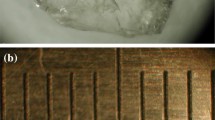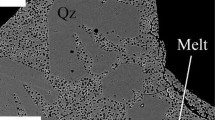Abstract
A single-crystal gemstone of intermediate olivine-type triphylite-lithiophilite with the composition Li(Fe0.56Mn0.42)P1.02O4 was investigated by vibrational spectroscopy and electron microscopy techniques. Though gem-quality, the crystal reveals lamellar, platy inclusions parallel to (100) with a length of up to > 10 μm and a thickness of up to 1–2 μm. These were identified as sarcopside, (Fe,Mn)3(PO4)2, yielding a higher Fe:Mn ratio than the host triphylite. Polarised infrared spectra of oriented triphylite sections show a weak, pleochroic band in the O-H stretching region that is centred at ~ 3444 cm-1. Its integrated total absorbance corresponds to a hydrogen content of only 3.7 wt.ppm H2O. Using peak-fitting techniques the band is decomposed into three component bands at ~ 3419, 3444, and 3474 cm-1 which are least intense in the [010] spectra and which show stronger absorptions in the [001] and [100] directions. Thus, O-H vectors almost parallel to the (010) plane, pointing closer to the a or to the c axes are assumed. Three ways of hydrogen incorporation are in agreement with this observation: (a) hydrous species at the oriented interfaces between triphylite host and sarcopside lamellae, (b) hydrogen from submicroscopic inclusions of hydrous phosphate minerals such as phosphoferrite-reddingite, (Fe,Mn)3(PO4)2 · 3H2O, (c) hydrous point defects in the structure of triphylite and/or sarcopside, which are possible under the assumption of vacancies at the Li (M1) and/or P sites.






Similar content being viewed by others
References
Andersson AS, Thomas JO, Kalska B, Häggström L (2000) Thermal stability of LiFePO4-based cathodes. Electrochem Solid-State Letters 3:66–68
Bauerhansl P, Beran A (1997) Trace hydrogen in the olivine-type minerals chrysoberyl, Al2BeO4 and sinhalite, MgAlBO4 – a polarized FTIR spectroscopic study. Schweiz Mineral Petrogr Mitt 77:131–136
Beran A, Libowitzky E (2006) Water in natural mantle minerals II: Olivine, garnet and accessory minerals. In: H Keppler, JR Smyth (eds), Water in Nominally Anhydrous Minerals. Rev Mineral Geochem 62:169–191
Beran A, Putnis A (1983) A model of the OH positions in olivine, derived from infrared-spectroscopic investigations. Phys Chem Minerals 9:57–60
Beran A, Langer K, Andrut M (1993) Single crystal infrared spectra in the range of OH fundamentals of paragenetic garnet, omphacite and kyanite in an eclogitic mantle xenolith. Mineral Petrol 48:257–268
Downs RT (2006) The RRUFF Project: an integrated study of the chemistry, crystallography, Raman and infrared spectroscopy of minerals. Program and Abstracts of the 19th General Meeting of the International Mineralogical Association in Kobe, Japan. O03-13
Fabre C, Boiron M-C, Dubessy J, Chabiron A, Charoy B, Crespo TM (2002) Advances in lithium analysis in solids by means of laser-induced breakdown spectroscopy: an exploratory study. Geochim Cosmochim Acta 66:1401–1407
Fehr KT, Hochleitner R, Schmidbauer E, Schneider J (2007) Mineralogy, Mössbauer spectra and electrical conductivity of triphylite Li(Fe2+, Mn2+)PO4. Phys Chem Minerals 34:485–494
Fransolet A-M, Antenucci D, Speetjens J-M (1984) An X-ray determinative method for the divalent cation ratio in the triphylite-lithiophilite series. Min Mag 48:373–381
Gose J, Schmädicke E, Markowitz M, Beran A (2010) OH point defects in olivine from Pakistan. Mineral Petrol 99:105–111
Hatert F, Roda-Robles E, Keller P, Fontan F, Fransolet A-M (2007) Petrogenetic significance of the triphylite + sarcopside intergrowths in granitic pegmatites: an experimental investigation of the Li(Fe,Mn)(PO4)-(Fe,Mn)3(PO4)2 system. Granitic Pegmatites: The State of the Art, Int Symp Book of Abstr 44
Hurlbut CS (1965) Detailed description of sarcopside from East Alstead, New Hampshire. Am Mineral 50:1698–1707
Johnson EA (2006) Water in nominally anhydrous crustal minerals: Speciation, concentration and geologic significance. In: H Keppler, JR Smyth (eds), Water in Nominally Anhydrous Minerals. Rev Mineral Geochem 62:117–154
Keppler H, Bolfan-Casanova N (2006) Thermodynamics of water solubility and partitioning. In: H Keppler, JR Smyth (eds), Water in Nominally Anhydrous Minerals. Rev Mineral Geochem 62:193–230
Langer K, Taran MN, Fransolet A-M (2006) Electronic absorption spectra of phosphate minerals with olivine-type structures: I. Members of the triphylite-lithiophilite series, M1[6]LiM2[6](Fe 2+x Mn 2+1-x )[PO4]. Eur J Mineral 18:337–344
Lemaire C, Kohn SC, Brooker RA (2004) The effect of silica activity on the incorporation mechanisms of water in synthetic forsterite: a polarised infrared spectroscopic study. Contrib Mineral Petrol 147:48–57
Libowitzky E (1999) Correlation of O-H stretching frequencies and O-H⋯O hydrogen bond lengths in minerals. Mh Chem 130:1047–1059
Libowitzky E, Beran A (2004) IR spectroscopic characterisation of hydrous species in minerals. In: A Beran, E Libowitzky (eds), EMU Notes Mineral, Vol 6. Eötvös Univ Press, p 227–279
Libowitzky E, Beran A (2006) The structure of hydrous species in nominally anhydrous minerals: Information from polarized IR spectroscopy. In: H Keppler, JR Smyth (eds), Water in Nominally Anhydrous Minerals. Rev Mineral Geochem 62:29–52
Libowitzky E, Rossman GR (1996) Principles of quantitative absorbance measurements in anisotropic crystals. Phys Chem Minerals 23:319–327
Libowitzky E, Rossman GR (1997) An IR absorption calibration for water in minerals. Am Mineral 82:1111–1115
Losey A, Rakovan J, Hughes JM, Francis CA, Dyar MD (2004) Structural variation in the lithiophilite-triphylite series and other olivine-group structures. Can Mineral 42:1105–1115
Moore PB (1972) Sarcopside: Its atomic arrangement. Am Mineral 57:24–35
Moore PB (1984) Crystallochemical aspects of the phosphate minerals. In: Nriagu JO, Moore PB (eds) Phosphate minerals. Springer, Berlin, pp 155–170
Moore PB, Araki T (1976) A mixed-valence solid-solution series: crystal structures of phosphoferrite, Fe II3 (H2O)3[PO4]2, and kryzhanovskite, Fe III3 (OH)3[PO4]2. Inorg Chem 15:316–321
Mosenfelder JL, Deligne NI, Asimow PD, Rossman GR (2006) Hydrogen incorporation in olivine from 2–12 GPa. Am Mineral 91:285–294
Novak A (1974) Hydrogen bonding in solids: correlation of spectroscopic and crystallographic data. Struct Bond 18:177–216
Nriagu JO (1984) Phosphate minerals: Their properties and general modes of occurrence. In: Nriagu JO, Moore PB (eds) Phosphate minerals. Springer, Berlin, pp 1–136
Padhi AK, Nanjundaswamy KS, Goodenough JB (1997) Phospho-olivines as positive-electrode materials for rechargeable lithium batteries. J Electrochem Soc 144:1188–1194
Prosini PP, Zane D, Pasquali M (2001) Improved electrochemical performance of a LiFePO4-based composite cathode. Electrochim Acta 46:3517–3523
Recham N, Casas-Cabanas M, Cabana J, Grey CP, Jumas J-C, Dupont L, Armand M, Tarascon J-M (2008) Formation of a complete solid solution between the triphylite and fayalite olivine structures. Chem Mater 20:6798–6809
Roda-Robles E, Galliski M, Nizamoff J, Simmons W, Keller P, Falster A, Hatert A (2011) Cation partitioning between minerals of the triphylite ± graftonite ± sarcopside association in granitic pegmatites. 5th Int Symp on granitic pegmatites - PEG2011, Abstract book 161–164
Rossman GR (2006) Analytical methods for measuring water in nominally anhydrous minerals. In: H Keppler, JR Smyth (eds), Water in Nominally Anhydrous Minerals. Rev Mineral Geochem 62:1–28
Smeds S-A, Uher P, Černý P, Wise MA, Gustafsson L, Penner P (1998) Graftonite—busite in Sweden: primary phases, products of exsolution, and distribution in zoned populations of granitic pegmatites. Can Mineral 36:377–394
Van Alboom A, De Grave E, Wohlfahrt-Mehrens M (2011) Temperature dependence of the Fe2+ Mössbauer parameters in triphylite (LiFePO4). Am Mineral 96:408–416
Vignola P, Diella V, Ferrari ES, Fransolet A-M (2011) Complex mechanisms of alteration in a graftonite + sarcopside + triphylite association from the Luna pegmatite, Piona, Lecco Province, Italy. Can Mineral 49:765–776
Wirth R (2004) A novel technology for advanced application of micro- and nanoanalysis in geosciences and applied mineralogy. Eur J Mineral 16:863–876
Wirth R (2009) Focused Ion Beam (FIB) combined with SEM and TEM: Advanced analytical tools for studies of chemical composition, microstructure and crystal structure in geomaterials on a nanometre scale. Chem Geol 261:217–229
Yamada A, Chung SC, Hinokuma K (2001) Optimized LiFePO4 for lithium battery cathodes. J Electrochem Soc 148:A224–A229
Yang S, Song Y, Zavalij PY, Whittingham MS (2002) Reactivity, stability, and electrochemical behavior of lithium iron phosphates. Electrochem Commun 4:239–244
Acknowledgements
Thanks are due to G. Giester for help with X-ray single-crystal orientation and lattice parameter determination, and to A. Wagner for sample preparation. B. Rieck provided two reference samples of phosphoferrite and reddingite. The comments of two anonymous referees and of journal editor R. Abart helped to improve the manuscript. We appreciate financial support by the European Commission through the program Human Potential-Research Training Network, No. HPRN-CT-2000-0056, “Hydrogen Speciation in Upper Mantle Minerals”.
Author information
Authors and Affiliations
Corresponding author
Additional information
Editorial handling: R. Abart
Rights and permissions
About this article
Cite this article
Libowitzky, E., Beran, A., Wieczorek, A.K. et al. On the presence of a hydrous component in a gemstone variety of intermediate olivine-type triphylite-lithiophilite, Li(Fe,Mn)PO4 . Miner Petrol 105, 31–39 (2012). https://doi.org/10.1007/s00710-012-0195-9
Received:
Accepted:
Published:
Issue Date:
DOI: https://doi.org/10.1007/s00710-012-0195-9




